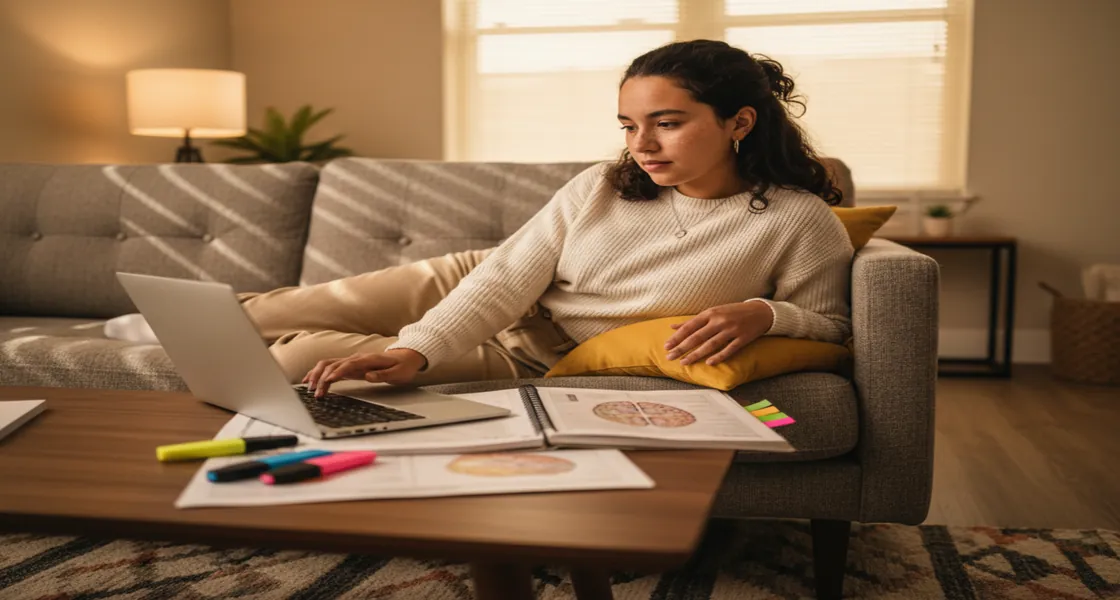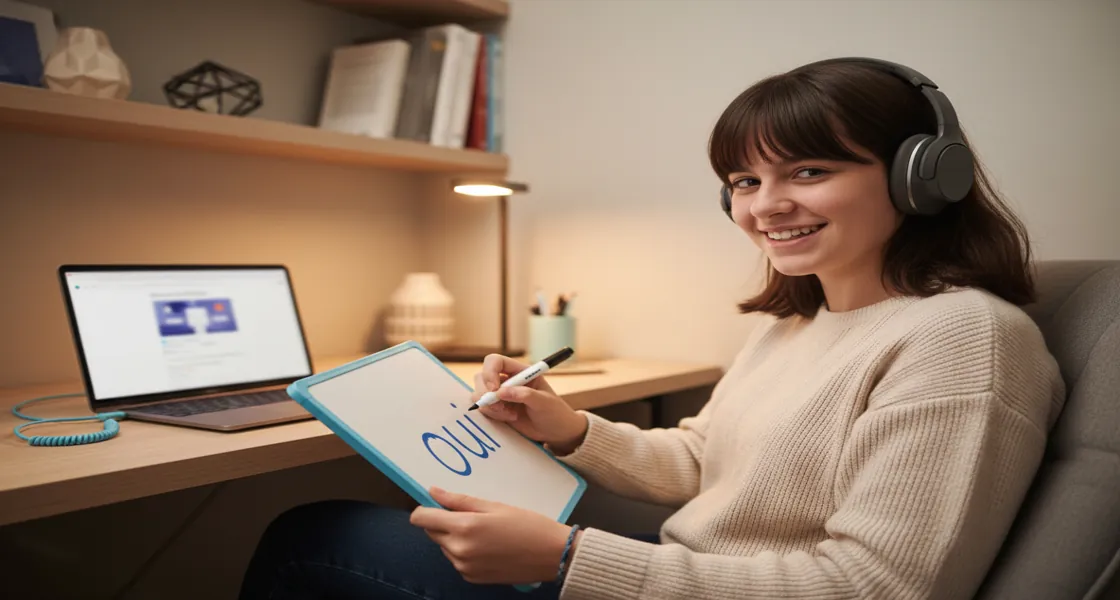Cursive writing might not appear as often in daily life, but it tends to spark curiosity when it does. Your learner may notice it in a signature, a birthday card, or a favorite book title. Teaching cursive is a chance to slow things down, build focus, and help your learner explore writing in a way that feels expressive and hands-on.
This guide walks you through simple, supportive steps for introducing cursive at home—from foundational strokes to full sentences. Along the way, you'll find tips, tools, and creative ideas to make practice feel purposeful and fun. And if you're looking for extra support or group energy, live cursive classes on Outschool can add structure, variety, and encouragement at just the right pace.
Why cursive writing matters
Cursive offers more than just a new way to shape letters—it allows your learner to write with rhythm, intention, and personal style. In a world where typing often comes first, cursive adds something tactile and thoughtful to the mix.
Learning cursive can also support key developmental skills. It strengthens fine motor coordination, reinforces hand-eye control, and helps with memory and focus through repetition and motion. Because cursive uses continuous strokes, it often becomes faster than block writing over time, freeing your learner to focus more on what they’re saying, not just how they’re writing it. As your learner practices flowing, connected strokes, they build both control and confidence.
Beyond the mechanics, cursive can feel personal and expressive. It gives your learner new ways to connect with older writing, with their own ideas, and with the act of writing itself. That sense of connection often keeps them engaged and turns practice into something meaningful.
Building basic strokes
Before your learner begins forming full letters, starting with the simple shapes that make cursive feel fluid and connected is helpful. These basic strokes are the building blocks of most cursive letters. Spending time with them first helps your learner feel more confident—and makes everything that follows a bit easier.
Key foundational strokes
Here are the core strokes to practice first:
- Undercurve: A soft curve that moves up and to the right. It’s used at the start of letters like c and a.
- Overcurve: A curved stroke that goes down and to the right, like the top of n or m.
- Downcurve: A small downward curve, found in parts of g and y.
- Upcurve: A gentle upward stroke from the baseline, often used to start letters like t or i.
There's no need to rush through these. Take time with each stroke—model it slowly, let your learner trace it, and then encourage them to try it on their own. Repetition at this stage builds comfort and a natural sense of rhythm.
Ways to explore these strokes
Once your learner is familiar with the motions, these activities can help reinforce them through practice:
- Tracing exercises: Offer large, flowing loops and curves for your learner to trace. Begin with big arm movements, then gradually shift to smaller, more controlled strokes as their confidence grows.
- Creative patterns: Let your learner fill a page with connected loops, curves, or zigzags—almost like designing their own cursive trail.
- Cursive doodles: Turn strokes into simple sketches—waves, spirals, clouds. This keeps things playful while reinforcing motor memory.
The goal here isn't perfect form or speed. It's about helping your learner feel relaxed and steady with each motion. That foundation will make letter formation much smoother later on.
Introducing lowercase letters
Once your learner feels confident with those basic shapes, you can introduce letters in small, related groups. Grouping by motion helps your learner recognize patterns and builds a sense of flow:
- Group 1: c, a, d, g, o, q (all begin with a rounded undercurve)
- Group 2: i, u, w, t, j, p, r, s (feature upward loops or similar strokes)
- Group 3: e, l, f, h, k, b (start with an overcurve or tall loop)
- Group 4: m, n, v, y, x, z (combine a mix of earlier strokes)
Work through one group at a time. Show how each letter moves from start to finish—first in the air, then slowly on paper. Let your learner trace letters using dotted-line worksheets or laminated cards they can reuse.
As they begin writing letters on their own, keep encouraging steady, smooth strokes and even spacing. Helping your learner build strong habits early on makes it much easier to connect letters into words later.
Adding uppercase letters
Uppercase cursive letters bring more variety in shape and starting points than lowercase ones. Because they often require more precision, it's best to wait until your learner feels steady and confident with lowercase writing before moving forward.
When they're ready, you can ease into capital letters by introducing them in small groups:
- Start with rounded letters like C, E, and G. These shapes feel more familiar and approachable.
- Save angular or detailed letters like A, M, and N for later, once your learner has built more control and rhythm.
To keep practice meaningful, look for chances to make it personal. Invite your learner to write their name in cursive, label their drawings, or make bookmarks with their initials. When cursive connects to their world—names, favorite words, or even silly titles—it feels useful and expressive, not just something to copy from a chart.
Connecting letters and words
Once your learner is comfortable forming individual letters, it's time to start linking them together. In this stage, cursive begins to feel more fluid, and your learner starts building a true sense of flow in their writing.
Start with easy letter pairs
Begin with simple two-letter combinations like in, to, on, or up. These short pairs allow your learner to focus on connecting letters smoothly without lifting the pencil. Model each pair slowly, then invite your learner to try tracing and writing them until the motion feels steady and natural.
Grow into familiar words
Next, move into short, everyday words—cat, dog, home, play. These familiar choices help your learner focus on letter connections and spacing without getting stuck on spelling or meaning. Keep the pace calm, and let neatness grow with practice.
Try simple sentences
As confidence builds, introduce basic sentences like "My cat is soft," "I like games," or "We had pizza." Guide your learner to connect each word while leaving a little space in between. At this point, it's less about perfect form and more about keeping the flow going from start to finish.
Make it personal and playful
Look for ways to tie cursive into daily life. Invite your learner to write a note to a sibling, label a drawing, or jot down three favorite things about their day. Prompts like "Write three things you love about summer" or "Send a secret message to a friend" can keep practice light and creative.
Celebrate small steps
Smooth, connected writing takes time—and every bit of progress counts. Cheer on the little moments: a cleaner loop, a straighter line, a quicker connection. These small wins build confidence and help your learner feel proud of their achievements.
Common questions about cursive writing
As cursive becomes more familiar, you might start thinking about supporting your learner's progress without letting their motivation dip. Here are a few questions that often come up during this next stretch of learning:
How can I help my learner write more smoothly?
Try short writing sessions focused on flow instead of perfect form. Let your learner write freely for a minute or two—no erasing or stopping—to build rhythm. Small tweaks, like experimenting with looser loops or tighter spacing, can make writing feel more natural.
When is the right time to set goals?
If your learner is writing short words and sentences consistently, it's a great time to introduce simple, specific goals. You might start with something like "connect three words without lifting the pencil" or "keep lowercase letters even in size." One goal at a time helps keep practice manageable and clear.
What's the best way to offer feedback?
Balanced, specific feedback works best. Point out something that's going well—"Your loops are looking really even"—before offering one focused suggestion. Avoid piling on corrections. A small, clear next step gives your learner something to try without discouragement.
How can they track their own progress?
Collect a few early writing samples and revisit them after a few weeks. Side-by-side comparisons make noticing improvements, like steadier strokes or more consistent spacing, easier. Seeing their growth is one of the best motivators to keep going.
Practice resources and tools
There's no single way to practice cursive that works for everyone, which makes it fun to teach. Some learners love the structure of step-by-step programs, while others stay more engaged when practice feels playful or creative. With a flexible mix of tools and activities, you can support your learner's growth in a natural, low-pressure, and meaningful way.
Practice programs and structured workbooks
For learners who benefit from clear, step-by-step guidance:
- Zaner-Bloser Handwriting: A well-known program that teaches print and cursive together, with consistent visuals and gradual progression.
- Handwriting Without Tears – Cursive Handwriting: Breaks cursive into manageable steps designed around developmental readiness.
- Learning Without Tears Digital Tools: Online activities that align with the workbook series for added flexibility.
Printable resources and visual models
Helpful for learners who absorb information best through seeing and tracing:
- Printable alphabet charts from K12Reader, The OT Toolbox, or similar education sites
- Tracing sheets, blank guideline templates, and practice grids
- Slow-motion videos that demonstrate how to form and connect letters with ease
Creative and playful practice ideas
To bring more fun and variety into daily practice:
- Write with colored gel pens, chalk, or scented markers to keep sessions interesting
- Turn favorite quotes or song lyrics into mini cursive art projects
- Create secret messages, thank-you cards, or scavenger hunt clues in cursive
- Tape a large sheet of paper to the wall or floor for a "graffiti-style" cursive space
Extra tools and flexible support
Great for mixing up the routine or offering alternative ways to learn:
- iTrace App: A simple, tablet-friendly app for practicing cursive through tracing
- Boom Cards Cursive Activities: Interactive, self-paced decks that make practice feel like a game
- CursiveLogic: A more structured option for older learners, grouping letters by similar strokes and shapes
Explore live classes on Outschool
For learners who benefit from real-time support, creative prompts, and social energy, Outschool offers a variety of live cursive classes you can build into your routine:
Helping your learner find their rhythm
Cursive takes time, and it looks a little different for every learner. Some days might feel smooth and focused, while others call for a lighter, more creative approach. What matters most is keeping the experience approachable—something your learner can return to without pressure.
As their writing grows more fluid, you may notice cursive appearing naturally: in a journal, on a piece of art, or scribbled next to a drawing. These small signs reflect more than skill—they show comfort and ownership.
If you want to add structure or fresh energy along the way, live cursive classes on Outschool offer just the right mix of guidance, encouragement, and peer connection. With real-time feedback and engaging prompts, your learner can keep building skills in a way that feels supportive and low-pressure.


.svg)
.svg)







